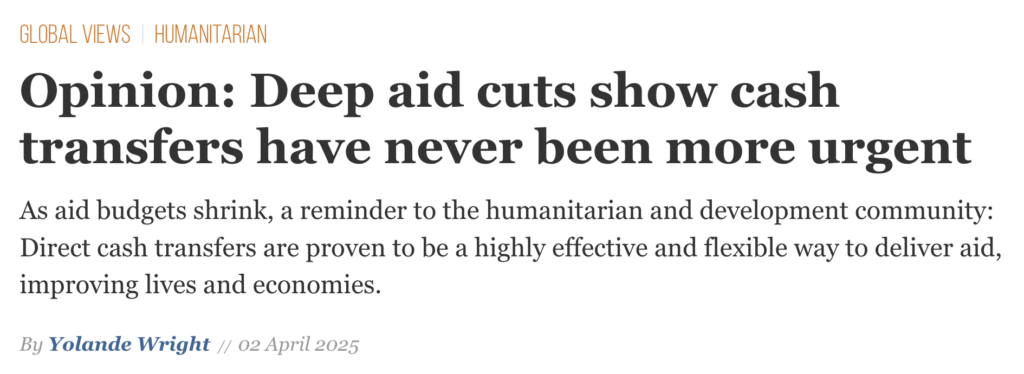The speed of the cuts to the U.S. Agency for International Development is probably the most significant shock wave to hit the sector since the start of official “Overseas Development Assistance” was classified in 1969. They are part of a wider trend — including cuts from the United Kingdom and many European donors — pushing us all to reevaluate the way forward. For years, rising aid budgets made it possible to accommodate both effective and ineffective programs. Cost-effective interventions such as cash transfers were added in at the margins, while traditional — but sometimes less well proven — projects continued to scale.
But today’s cuts, paired with rising global needs, make that complacency untenable. We cannot just ask: “Who will fill the gap?” We must also ask: “How do we spend better?”
Fortunately, we are not short of ideas on what works.
Two decades of research evidence from the likes of J-PAL and IPA have created a wealth of evidence on cost effectiveness. Conversely, programs such as public works, nutrition classes, and job training schemes have been less impactful than we hoped. Direct cash transfers, for example, have proven effective across a range of outcomes: improving household income, boosting consumption, reducing food insecurity, and supporting health and education.
Some aid leaders are speaking up. Tom Fletcher, the head of UNOCHA, recently called for a “humanitarian reset,” advocating a shift toward more cash programming. Former U.K. Development Secretary Rory Stewart told the British Parliament: “This is the time to be much bolder about cash because cash is very effective, very efficient, very transparent.”
Yet despite years of advocacy from groups that work in cash-transfer programs, and convenors such as the CALP network, today only around 20% of humanitarian aid is given as cash or vouchers — far short of the 30% to 50% experts suggest could be. While humanitarian cash can play a lifesaving role — such as preventing starvation and enabling access to vital health care — the amounts are often too small to support real recovery.
We must think bigger. For example, combining a year of survival cash into a single lump sum can allow families to make investments that reduce long-term dependency — delivering better outcomes and lowering costs over time.
But there are political headwinds. At GiveDirectly, my organization, we’ve seen seven USAID-funded direct cash programs defunded in recent weeks. While the U.S. is reinstating some lifesaving aid, it is seemingly excluding multipurpose cash assistance.
As agencies fight for survival, there is a risk of retreating to familiar, politically palatable approaches such as in-kind food aid. Indeed last year, the share of humanitarian assistance delivered as cash and vouchers dropped to its lowest level in nearly a decade.
Cash also faces a perception challenge: It’s harder to justify to populist voters than tangible goods. Giving someone in extreme poverty direct funds can seem controversial when voters at home are struggling — while nutrition training or bags of grain feel less politicized, even if they’re ultimately worse value for money.
We must meet these concerns head on, not retreat. Cash assistance is not just well-used — it’s often better used than many conventional aid programs. If critics worry about waste, we can point to mobile money systems that deliver up to 80% of funds directly to recipients, with clear, trackable outcomes.
Large, well-designed cash transfers go beyond emergency relief. They support development by stimulating local economies and fostering self-reliance, scaling rapidly through existing digital infrastructure. And crucially, they restore dignity — providing individuals with the opportunity for self-determination, enabling them to address their own development priorities.
Agencies are now weighing hard trade-offs between funding education, nutrition, health care, food security, or livelihoods. Yet if we could lift our heads above this sectoral view, we’d see flexible direct cash transfers allow families to improve all these outcomes with a simple intervention.
We’re not suggesting cash is a silver bullet. Basic services — health, education, water-supplies etc. — are also critical and must be funded. But cash is uniquely positioned to meet this moment. As other services vanish, cash gives people flexibility — whether to travel to the nearest open clinic, buy food no longer delivered, or purchase medicine that was once provided for free. It’s not just effective — it’s highly flexible, and localized.
This isn’t a radical idea. Globally, diaspora from lower-income countries have long outpaced formal aid with billions in remittances — because they know people in need can and should be trusted. The aid sector should follow their lead.
We’re at an inflection point. If we simply try to fill gaps with the same old programs, we’ll fall short. But if we let this crisis push us toward smarter, evidence-based, recipient-led solutions, we can do more good — with fewer dollars.
